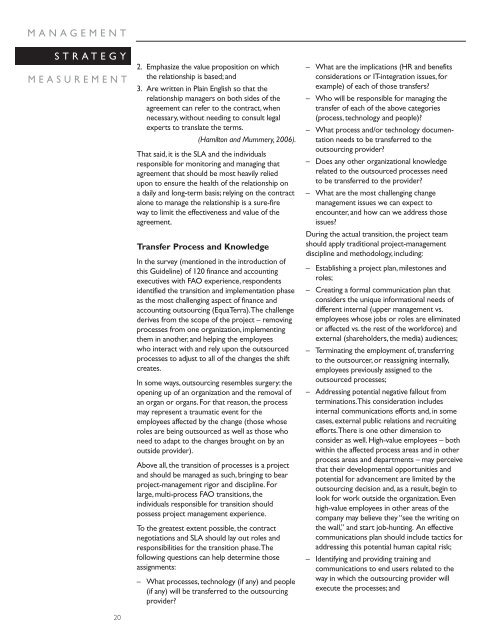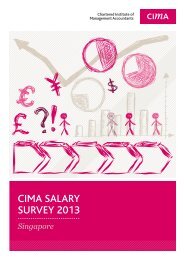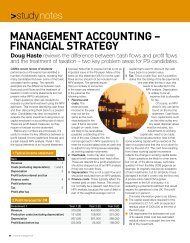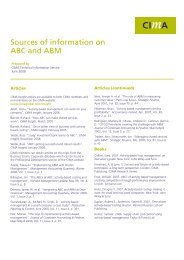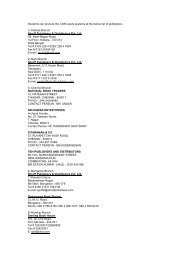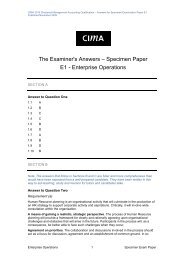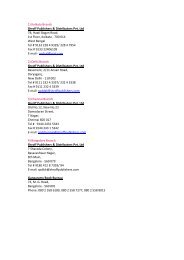Outsourcing the Finance and Accounting Functions - CIMA
Outsourcing the Finance and Accounting Functions - CIMA
Outsourcing the Finance and Accounting Functions - CIMA
Create successful ePaper yourself
Turn your PDF publications into a flip-book with our unique Google optimized e-Paper software.
MANAGEMENT<br />
STRATEGY<br />
MEASUREMENT<br />
20<br />
2. Emphasize <strong>the</strong> value proposition on which<br />
<strong>the</strong> relationship is based; <strong>and</strong><br />
3. Are written in Plain English so that <strong>the</strong><br />
relationship managers on both sides of <strong>the</strong><br />
agreement can refer to <strong>the</strong> contract, when<br />
necessary, without needing to consult legal<br />
experts to translate <strong>the</strong> terms.<br />
(Hamilton <strong>and</strong> Mummery, 2006).<br />
That said, it is <strong>the</strong> SLA <strong>and</strong> <strong>the</strong> individuals<br />
responsible for monitoring <strong>and</strong> managing that<br />
agreement that should be most heavily relied<br />
upon to ensure <strong>the</strong> health of <strong>the</strong> relationship on<br />
a daily <strong>and</strong> long-term basis; relying on <strong>the</strong> contract<br />
alone to manage <strong>the</strong> relationship is a sure-fire<br />
way to limit <strong>the</strong> effectiveness <strong>and</strong> value of <strong>the</strong><br />
agreement.<br />
Transfer Process <strong>and</strong> Knowledge<br />
In <strong>the</strong> survey (mentioned in <strong>the</strong> introduction of<br />
this Guideline) of 120 finance <strong>and</strong> accounting<br />
executives with FAO experience, respondents<br />
identified <strong>the</strong> transition <strong>and</strong> implementation phase<br />
as <strong>the</strong> most challenging aspect of finance <strong>and</strong><br />
accounting outsourcing (EquaTerra).The challenge<br />
derives from <strong>the</strong> scope of <strong>the</strong> project – removing<br />
processes from one organization, implementing<br />
<strong>the</strong>m in ano<strong>the</strong>r, <strong>and</strong> helping <strong>the</strong> employees<br />
who interact with <strong>and</strong> rely upon <strong>the</strong> outsourced<br />
processes to adjust to all of <strong>the</strong> changes <strong>the</strong> shift<br />
creates.<br />
In some ways, outsourcing resembles surgery: <strong>the</strong><br />
opening up of an organization <strong>and</strong> <strong>the</strong> removal of<br />
an organ or organs. For that reason, <strong>the</strong> process<br />
may represent a traumatic event for <strong>the</strong><br />
employees affected by <strong>the</strong> change (those whose<br />
roles are being outsourced as well as those who<br />
need to adapt to <strong>the</strong> changes brought on by an<br />
outside provider).<br />
Above all, <strong>the</strong> transition of processes is a project<br />
<strong>and</strong> should be managed as such, bringing to bear<br />
project-management rigor <strong>and</strong> discipline. For<br />
large, multi-process FAO transitions, <strong>the</strong><br />
individuals responsible for transition should<br />
possess project management experience.<br />
To <strong>the</strong> greatest extent possible, <strong>the</strong> contract<br />
negotiations <strong>and</strong> SLA should lay out roles <strong>and</strong><br />
responsibilities for <strong>the</strong> transition phase.The<br />
following questions can help determine those<br />
assignments:<br />
– What processes, technology (if any) <strong>and</strong> people<br />
(if any) will be transferred to <strong>the</strong> outsourcing<br />
provider?<br />
– What are <strong>the</strong> implications (HR <strong>and</strong> benefits<br />
considerations or IT-integration issues, for<br />
example) of each of those transfers?<br />
– Who will be responsible for managing <strong>the</strong><br />
transfer of each of <strong>the</strong> above categories<br />
(process, technology <strong>and</strong> people)?<br />
– What process <strong>and</strong>/or technology documentation<br />
needs to be transferred to <strong>the</strong><br />
outsourcing provider?<br />
– Does any o<strong>the</strong>r organizational knowledge<br />
related to <strong>the</strong> outsourced processes need<br />
to be transferred to <strong>the</strong> provider?<br />
– What are <strong>the</strong> most challenging change<br />
management issues we can expect to<br />
encounter, <strong>and</strong> how can we address those<br />
issues?<br />
During <strong>the</strong> actual transition, <strong>the</strong> project team<br />
should apply traditional project-management<br />
discipline <strong>and</strong> methodology, including:<br />
– Establishing a project plan, milestones <strong>and</strong><br />
roles;<br />
– Creating a formal communication plan that<br />
considers <strong>the</strong> unique informational needs of<br />
different internal (upper management vs.<br />
employees whose jobs or roles are eliminated<br />
or affected vs. <strong>the</strong> rest of <strong>the</strong> workforce) <strong>and</strong><br />
external (shareholders, <strong>the</strong> media) audiences;<br />
– Terminating <strong>the</strong> employment of, transferring<br />
to <strong>the</strong> outsourcer, or reassigning internally,<br />
employees previously assigned to <strong>the</strong><br />
outsourced processes;<br />
– Addressing potential negative fallout from<br />
terminations.This consideration includes<br />
internal communications efforts <strong>and</strong>, in some<br />
cases, external public relations <strong>and</strong> recruiting<br />
efforts.There is one o<strong>the</strong>r dimension to<br />
consider as well. High-value employees – both<br />
within <strong>the</strong> affected process areas <strong>and</strong> in o<strong>the</strong>r<br />
process areas <strong>and</strong> departments – may perceive<br />
that <strong>the</strong>ir developmental opportunities <strong>and</strong><br />
potential for advancement are limited by <strong>the</strong><br />
outsourcing decision <strong>and</strong>, as a result, begin to<br />
look for work outside <strong>the</strong> organization. Even<br />
high-value employees in o<strong>the</strong>r areas of <strong>the</strong><br />
company may believe <strong>the</strong>y “see <strong>the</strong> writing on<br />
<strong>the</strong> wall,” <strong>and</strong> start job-hunting. An effective<br />
communications plan should include tactics for<br />
addressing this potential human capital risk;<br />
– Identifying <strong>and</strong> providing training <strong>and</strong><br />
communications to end users related to <strong>the</strong><br />
way in which <strong>the</strong> outsourcing provider will<br />
execute <strong>the</strong> processes; <strong>and</strong>


